✔️ which features are crucial for any messenger,
✔️ what pros and cons the market leaders have,
✔️ how much time and money messenger app development takes, and how to make one.
Check it out!Messaging app statistics
Over three billion people have used messengers in 2021, and the number of users increases every month, which makes them one of the most popular application types. WhatsApp and Facebook Messenger are the most used messengers across the world, while WeChat is the most popular messenger used in China. In the USA, messaging apps are the second most popular method of communication after social media platforms. According to Facebook’s research, 80% of adults and 91% of teens message every day. And even when it comes to dating apps, 34% of people who start conversations on a dating app will continue it in a messenger.Here are the most popular global mobile messenger apps as of January 2022:
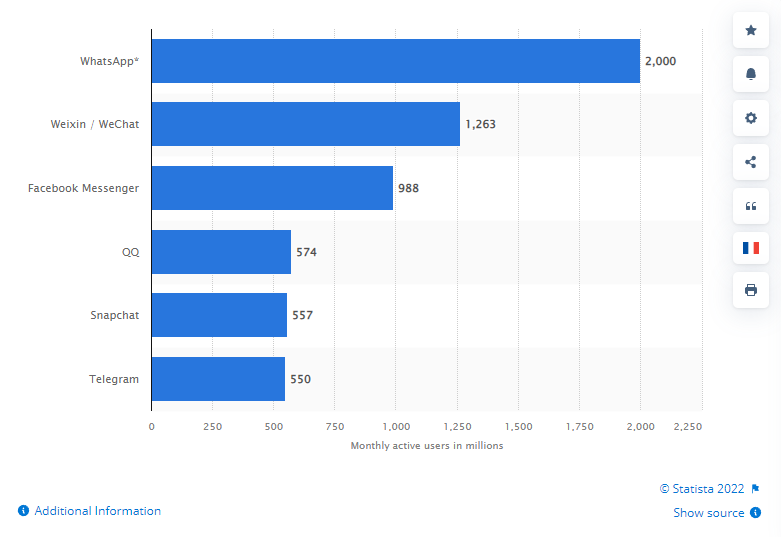 Data from Statista.
Data from Statista.
Must-have features of a messaging app
To create a chat app and make it work, you need to start with basic features. These things might seem obvious, but if you neglect them, users won’t appreciate that.✔️ Authorization
There are several ways to create authorization: via email, social media, or phone number. We suggest that the sign-up process should be as simple as possible to avoid creating any obstacles for users. Large sign-up forms with multiple fields can scare users away — better make it possible to sign in with one click. WhatsApp and Telegram use authorization with a phone number and validation with an SMS.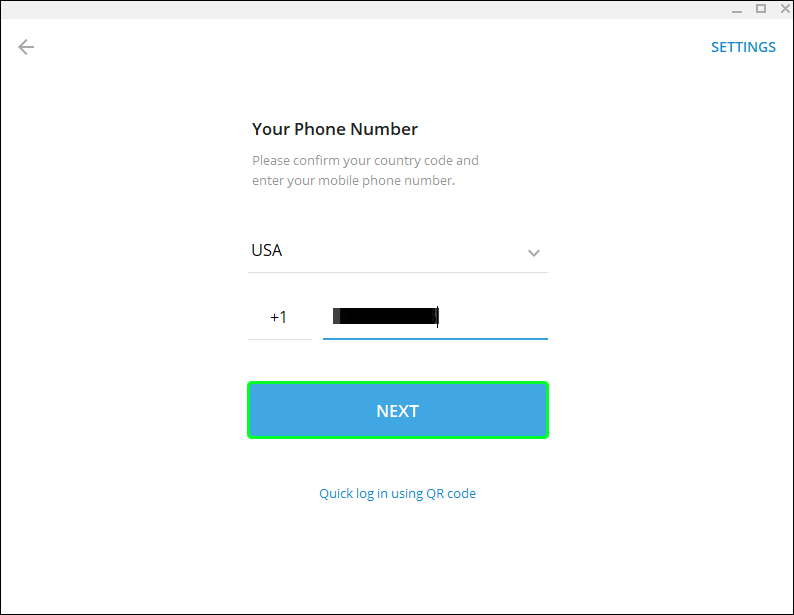 It’s better not to ask for unnecessary information from users, they can add it later in their profiles.
It’s better not to ask for unnecessary information from users, they can add it later in their profiles.
✔️ Contact importing
Once a user signs in, their contacts need to be automatically imported to the messaging app. It’s possible to add contacts not only from the contact books but also from the users’ social media accounts. You also need to show the users which of their contacts already use the app and let them invite their friends. It will highly increase the chance that the users will stay in the app.✔️ Cloud data storage
You need to store users’ messages in the cloud so that they have access to their chats anytime and from any device. Saving all the data on the users’ phones is a bad idea, not a single user likes to have GIF postcards sent by their grandma saved in their phone gallery without permission.Most users are also concerned about the security of their messages, they fear that strangers will be able to read their chats and get their info. In this case, it would be great to implement end-to-end encryption so that only the sender and the receiver of the message could see its contents. Facebook Messenger encrypts not only direct messages but also group chats and calls.
Don’t forget to show message status:
✅ delivered,
✅ seen,
✅ edited,
✅ deleted,
✅ failed.
Although, it’s not necessary to show the ‘deleted’ and ‘edited’ statuses to recipients.
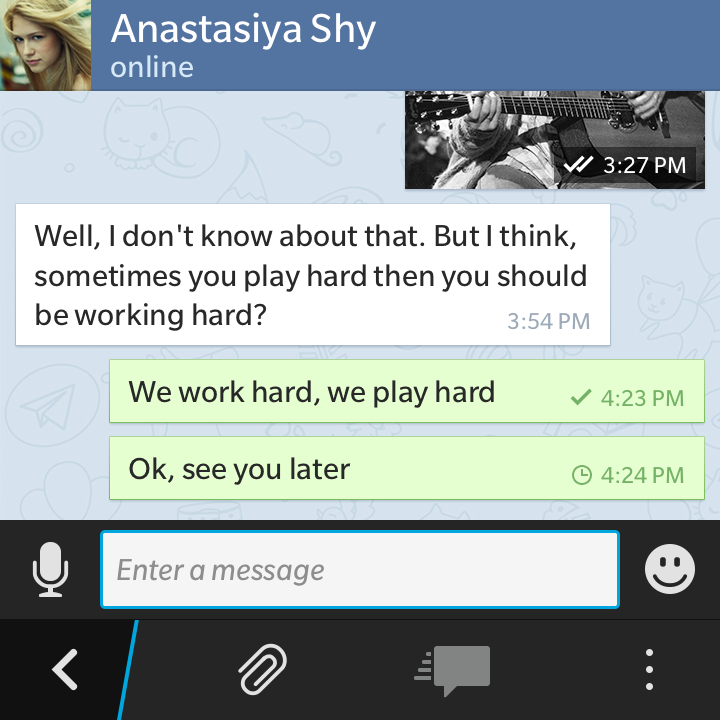 Message statuses on Telegram.
Message statuses on Telegram.
✔️ File sharing
Apart from sending messages, people also want to send emojis and stickers and share photos, videos, and different files. According to research done by Facebook, 57% of people respond to messages with GIFs, while 56% send messages using only emojis. If you offer users just text messages, it’s possible that they will quickly abandon the app.To implement this feature when creating a messaging app, you need to use distinct APIs. The app should allow users to send existing files, and to take photos and videos directly from the app and send them immediately.
✔️ Push notifications
A messaging app simply cannot exist without notifications. Users won’t know that someone replied to their message if the app doesn’t notify them. It’s inconvenient to open the app every once in a while to check for new messages. You can implement this feature using Apple Push Notifications or Google Cloud Messaging.✔️ Voice messages and calls
You might think that this feature is not very important since the app can work perfectly without it. Yes, it’s not vital, but what kind of messaging app doesn’t allow users to call each other and send voice messages? Even if you create a messaging app that is super fast and secure, we believe that users will choose other apps that provide calling features. It’s just more convenient to use one app for all communication methods rather than one app for calling, another app for texting, etc.Get inspire by market leaders to overcome them! Yes and no features
This was a list of basic features that every messenger needs. But there are many apps on the market that have those features, so how can you make a messaging app that stands out from competitors? You need to adopt their best practices and find their weak points to make your app better. We’ve done some research for you and highlighted the best and the worst features of popular messaging apps.Facebook Messenger
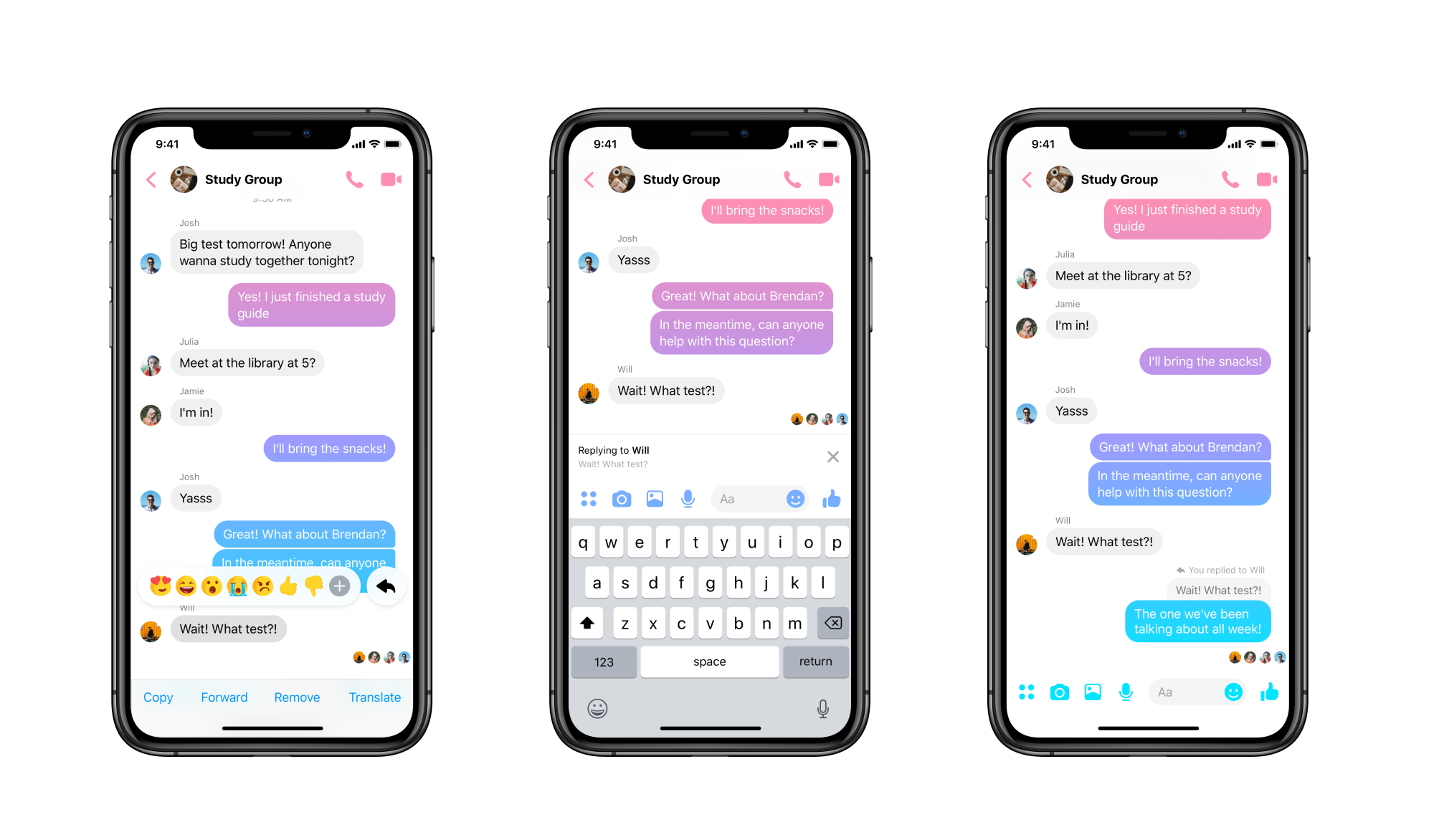
The general interface of Facebook Messenger.
As we already mentioned, statistically, Messenger is one of the most used chat apps around the world. Basically, it’s part of the Facebook ecosystem that allows users to send and receive messages via Facebook.We think that the coolest features of Messenger are that you can share your geolocation with friends and that you can send them money through the app. Another cool feature is that you can chat with people on Instagram right in Messenger. It means that you can have all your Facebook and Instagram chats in one place, and you don’t need to switch apps.
Talking about Messenger’s drawbacks, users complain that the user interface works slowly, the app crashes often, feels too heavy, and consumes a lot of battery. Users also don’t like that they’re forced to use Messenger if they use the Facebook app — without it, they simply can’t use the chat. If you only have a few business contacts on Facebook, it’s really inconvenient, because you need to use two apps instead of one.
In our opinion, the main advantage of WhatsApp is its popularity. Probably most of your relatives have WhatsApp, so you can easily chat with them there. All the messages in the app can be end-2-end encrypted, it’s light and fast. Another good feature is that you can choose backup options.
Despite WhatsApp’s popularity, it has a lot of drawbacks. The main disadvantage is that the app shares a lot of your information with Facebook — it can be your phone number, location, contacts, and content. Basically, anything you store on WhatsApp. Also, the app can be active only on one device at a time. This means you can’t simultaneously use it on your phone and your PC. The app’s UI/UX design is slightly outdated, at least it can be improved.
The most annoying thing about WhatsApp is that it saves all the photos and videos sent to you on your phone. It also misses a lot of features that other messengers have. Users can’t edit sent messages, deleted messages stay in the chat and the receiver sees that the sender deleted a message, etc.
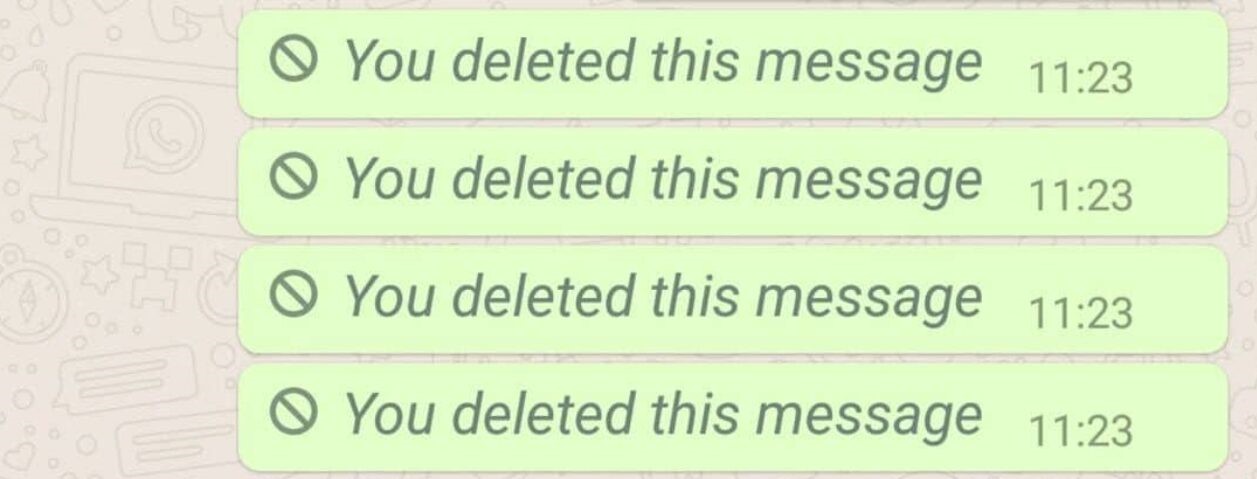 To create a chat app better than WhatsApp, it’s better to avoid such annoying features as we’ve mentioned in the text above.
To create a chat app better than WhatsApp, it’s better to avoid such annoying features as we’ve mentioned in the text above.
Viber
Viber is another famous messaging app with more than 820 million monthly active users. The app is mostly used in Eastern Europe. If you’re worried about Zuckerberg collecting your info, Viber is absolutely Facebook-free — the company cut all its ties with Facebook in 2020.Viber provides end-to-end encryption, it’s possible to set disappearing messages, and you can use the app on multiple devices. You can verify the identity of who you’re chatting with by exchanging secret keys. Also, users can hide their seen and online statuses.
Now about bad news: Viber doesn’t work on mobile data, only on wi-fi. The company also chose the wrong monetization format which led to the outflow of users. The free version has very annoying ads, while the premium version doesn’t have any additional features, so users are irritated in both cases. The received files are instantly saved and kept in users’ phones’ storage. Viber doesn’t have a backup — if you uninstall Viber and then reinstall it, all your messages and chat histories are gone.
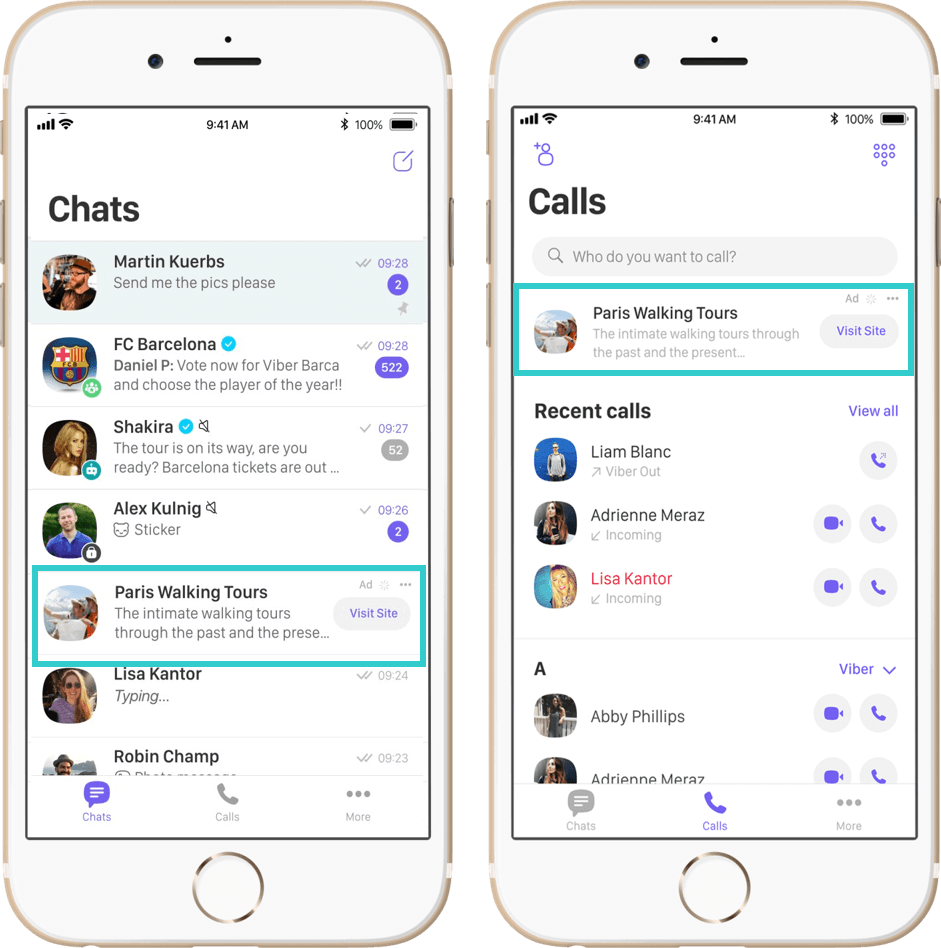 To create a chat app that will overcome Viber, it’s better to avoid unwanted ads.
To create a chat app that will overcome Viber, it’s better to avoid unwanted ads.
Telegram
Telegram is the most feature-rich messaging app on the list. It has voice and video calls and messages, group chats, chatbots, channels, free custom stickers, emoji reactions, custom themes, polls, web and desktop versions, and a lot more.The best thing about Telegram is that it’s safe — it provides a high level of end-to-end encryption, and has secret chats and self-destructing messages. In the app, even conference calls can be encrypted. You can mute contacts and groups: it’s very useful when you participate in several discussions because notifications can be very annoying, but turning off all notifications is also bad. Users can schedule messages, pin them in chats, and delete messages not only for themselves but also for the recipients. Telegram also saves drafts of all unsent messages and syncs them across all devices.
Talking about Telegram’s disadvantages, it’s not as popular as WhatsApp, so your friends and relatives might have not even heard of it. When people from your contacts install Telegram, the app sends you a notification and automatically creates a chat with them, even if you don’t want to chat with them. Plus, chat folders are not very convenient: you have a folder with all the chats and channels, and if you add some chats to another folder, you will get notifications from one chat in both folder tabs. This thing is not crucial, but definitely can be improved.
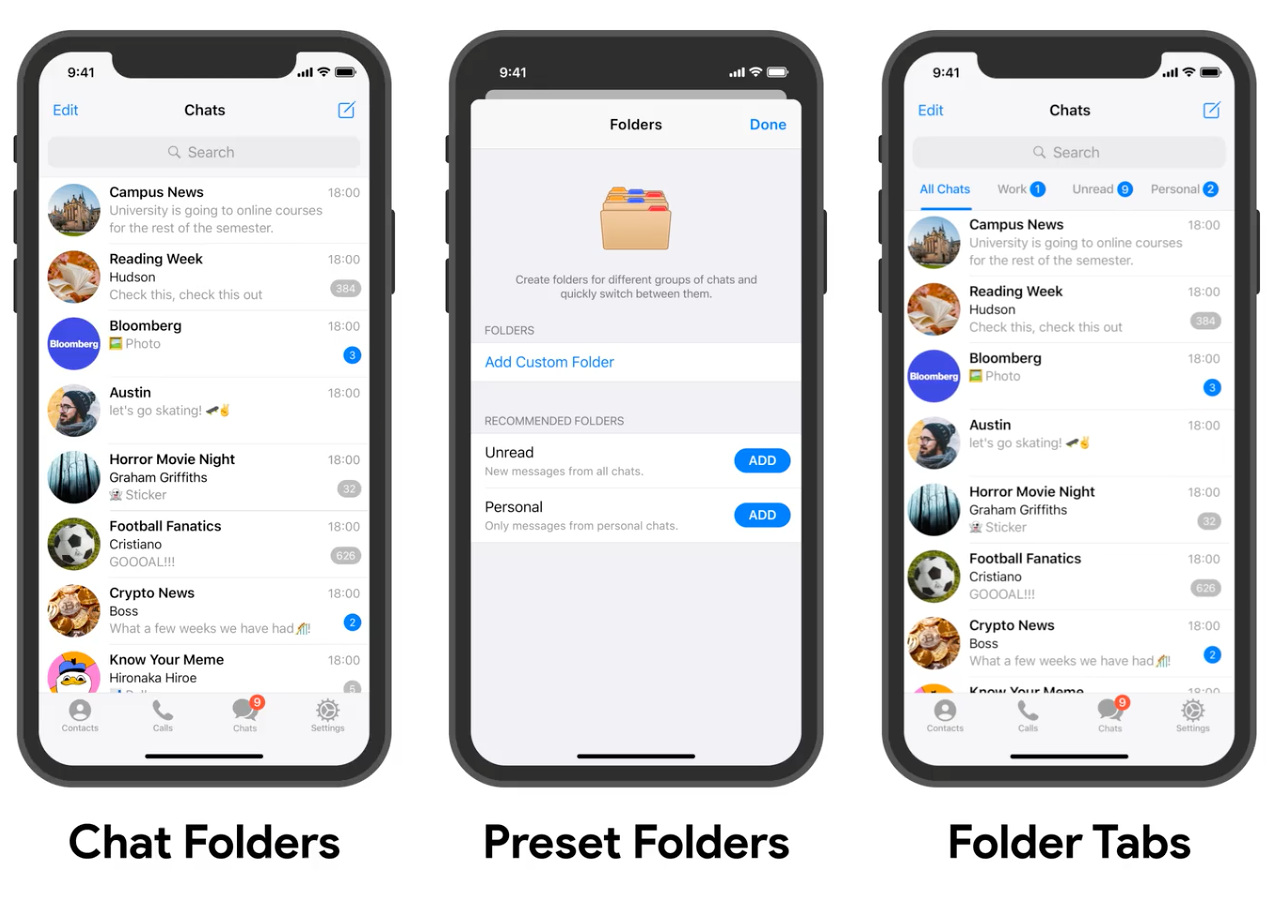
That’s what folders on Telegram look like.
As you can see, users are mostly worried about their privacy and data security. If you want to create a chat app, we suggest focusing on end-to-end encryption and other security features. The app definitely needs to be lightweight and fast, and basic features should work seamlessly. We don’t recommend placing ads where users don’t want to see them, it’s better to create an ad network that won’t bother users.Brivian’s experience with messenger app development
At Brivian, we provide mobile app development services for all kinds of businesses. One of our recent projects was called Biocoded — the client’s request was to make a messaging app with advanced security features. We developed the app for iOS and Android and made sure that it provides full end-to-end encryption. It has free default features like encrypted voice and conference calls, text messages, photos, and group chats. There are 2 paid features called Evidence and Bot. Evidence allows users to create a confidential live stream with recording. Bot is a chatbot that helps users manage their autonomous vehicles.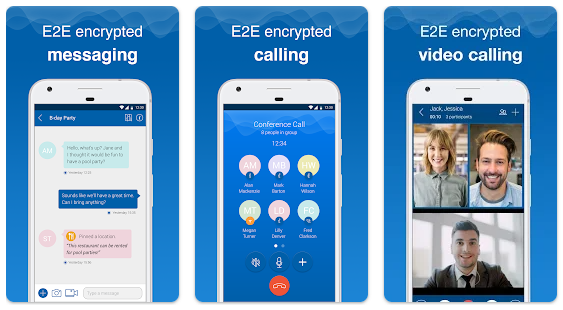 Brivian team is ready to help you create a chat app and make it secure.
Brivian team is ready to help you create a chat app and make it secure.
Cost and timeline for making a messaging app
In mobile app development, there are two main ways to create a chat app — native and cross-platform development. In the first case, you use native languages for iOS and Android platforms and create two separate apps. In the latter case, you use a cross-platform framework like React Native to build one application that will run on both operating systems. Native development is usually more expensive and takes more time.Of course, you can focus on one platform and make only one application. But when it comes to messenger app development, we don’t recommend ignoring one of the platforms. If you decide to develop an application just for iOS, Android users won’t be able to chat with iPhone users, and you will lose a big part of the audience.
At Brivian, native mobile app development takes about 4 months and costs $45.000 on average. As for cross-platform apps, it’s 2 months and $30.000 on average.
These prices are approximate — the final cost depends on the number of features, the complexity of the design, and the needed technologies. To get a precise estimate, fill in the form below, and our managers will contact you in 24 hours 🙂